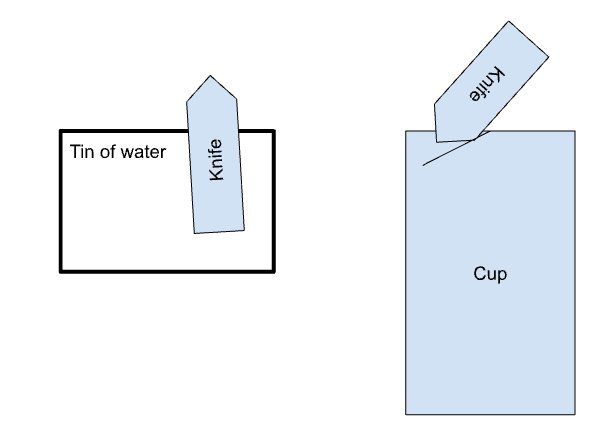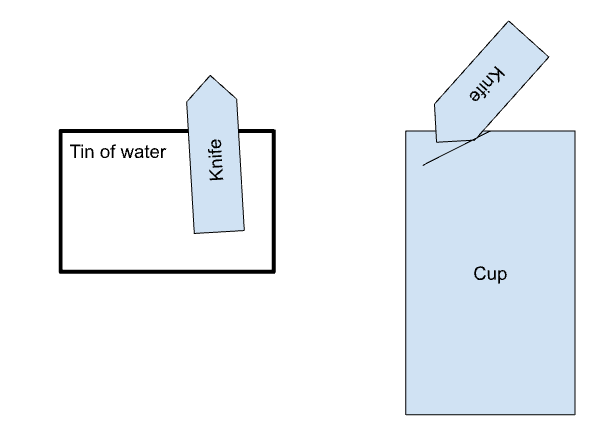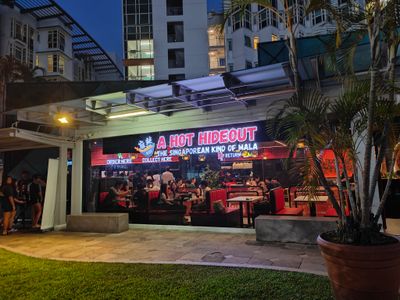"FASS has a communal knife too?"
"What?"
It was my first time getting a drink from the Deck on the Kent Ridge campus–I held a teh o kosong peng in my left hand, angling it so my right could pierce the lid with the knife. Drinks demanded surgical precision in their opening. I made a small cut in the plastic and set the knife back in its metal tin of water.
I was not the first student to use the knife today, and I wouldn't be the last. Hundreds, or thousands, or maybe hundreds of thousands of people had held the same knife to open up their sealed drinks. I couldn't remember a time where the knife had not been there–it was something certain, an innate truth about the world we lived in.
"I thought only the Law campus had a communal knife."
This sentence felt elitist, but over something that was not very elite at all. Before today, I'd just assumed that the communal knife was a freak of nature limited to the Summit drinks stall.
It didn't help that I didn't really talk to my Kent Ridge campus friends about the state of the drinks stalls. We generally had more interesting things to discuss. And so I'd laboured under the misapprehension that the communal drink knife did not exist outside of BTC, when in fact its Kent Ridge peer had been here all along.
Ordering drinks at hawker centres, on the other hand, didn't usually yield a communal knife. Is there something special about the college setting that lends itself to the communal knife? Because I know that if any public coffee shop drinks stall were to implement the use of a communal cup-opening knife, we'd see public outrage within the week. And yet the knife soldiered on in the college setting, all too happy to meet the needs of thirsty Deck-goers.
A convenient way to open up your drink while minimizing the spill-risk of an open-faced cup. That's what the knife offered. That's all that it was. No need to overthink it–
"But honestly," I said, taking a sip, "Isn't the idea of a communal knife kind of gross?"
–
I think the communal knife is the result of two timely factors:
- The push to eliminate plastic waste, which led to the push to eliminate straws, which led drink stalls to still seal the drinks up but simply stop providing straws.
- The need for portability – students and staff alike are on-the-go. Open-faced cups spill too easily and aren't ideal for lugging around school. Hence, cups have to be sealed.
Let's admit it now – the way the knife is stored is kind of gross. Here's how the communal knife works, in broad strokes:

I can't put my finger on what grosses me out about it. Maybe it's that the knife languishes in a pool of sepia-coloured water between uses. Maybe it's that I feel like I'm swapping spit with everyone in BTC when I use the knife to open my drink. It's not true, but still. The feeling persists.
"But you use the knife before your mouth even touches the cup," my friend correctly pointed out. "It just feels gross."
That's true. Really, the only way any biological contamination would happen would be if I licked the seal of the drink before piercing it with the knife, or if a particularly determined person licked the knife before putting it back. The communal knife works on an honour system, so I had reason to doubt that anyone had done that. It's a social contract we agree to abide by. We get our drink, we slice open the top, and we move on.
In the process of writing this article, my editor Sam asked me: "Do we really have to seal the cups if we're going to stab them open anyway?"
I think we seal cups only to stab them the same reason we fill piñatas to burst them; the same reason we forge candles only to burn them to the wick. There's something nice about having that measure of control over destruction.
Then Sam told me to answer the question 'for real', whatever that might mean. I can't really answer him, honestly, because I don't know why I just don't forgo the drink's sealing. We could all make do with open-faced cups, as they are often served outside. I know I'd prefer my drinks sealed, which necessitates use of the communal knife, which brought me back to the same question: Why do I think the knife's gross?
–
- Maybe I'm jealous of the knife and its easygoing, affable nature. The knife knows the warmth and grace of everyone who buys a drink; perhaps my discomfort with it hints at my own insecurities?
- Maybe I'm jealous of everyone else who gets to touch the knife; maybe I wish it were exclusively mine.
- Maybe I was envious of its position: That while I had to attend class, it could lounge in its own little jacuzzi of a metal tin.
"I don't think it's any of that," my friend commented, looking mildly nauseated. We were a few paces away from the drink stall now, and I looked down at my drink again.
I don't hate the communal drink stall knife.
It helps us retain some control over our lives by letting us dictate how big and how deep we want the opening of our drink to be. You might make a little slit if you have a straw, or an intense, gaping wound if you have a very big knife. It's not dirty – it might seem that way at first glance, but it doesn't actually touch anything that would cause cross-contamination. It minimizes plastic straw use. Pretty good, actually.
And it's become a welcome part of my life. I've begun to find joy in making the perfect slice in my lids. My mom says it'll make microplastics fall into my drink and then I'll drink the microplastics and then I'll die and decompose into microplastics. I mean, she's not wrong, but I'm not going to stop using the communal knife. I even enjoy that the BTC knife is serrated, unlike the knife at the Deck which is a normal kitchen knife with a sharp point. It could be commentary on how Law students aren't as sharp as we think.
The more I think about it, the less gross it gets.
Maybe I love the communal drink stall knife.



